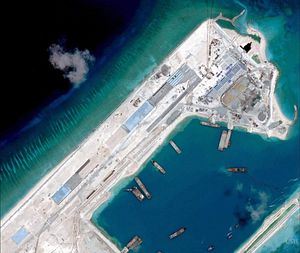The United States’ upcoming annual defense spending bill, the 2019 National Defense Authorization Act (NDAA), was passed by the Senate and now needs House approval before being signed into law by President Donald Trump. The bill authorizes $717 billion in appropriations for the U.S. Department of Defense.
The bill contains a few interesting provisions on the South China Sea that may be significant, if we see follow-through. South China Sea-watcher Greg Poling highlights two important provisions, both included in the Senate-passed NDAA text.
First, the 2019 NDAA will require greater public transparency from the U.S. Department of Defense on Chinese militarization activities and potential new land reclamation in the South China Sea. This is in line with long-standing recommendations by many South China Sea watchers in the United States, who see this kind of naming-and-shaming as a valuable way to highlight China’s continuing militarization activites on disputed features.
The bill text notes:
… immediately after the commencement of any significant reclamation or militarization activity by the People’s Republic of China in the South China Sea, including any significant military deployment or operation or infrastructure construction, the Secretary of Defense, in coordination with the Secretary of State, shall submit to the congressional defense committees, and release to the public, a report on the military and coercive activities of China in the South China Sea in connection with such activity
The public reporting requirement is further specified:
Each report on a significant reclamation or militarization activity under subsection (a) shall include a short narrative on, and one or more corresponding images of, such significant reclamation or militarization activity.
Follow-through on these requirements will be a welcome development in public awareness of Chinese militarization activities in the South China Sea and add to years of open source analysis based on satellite imagery, including at The Diplomat, of China’s gradual moves to militarize the Spratly group.
Notably, in 2016, the Hague-based tribunal at the Permanent Court of Arbitration that ruled largely in favor of the Philippines in its 2013 case against China over maritime entitlements and coercive behavior in the South China Sea cited open source analysis, including work first published at The Diplomat.
Separately, as Poling also highlights, the 2019 NDAA requires the U.S. secretary of defense to certify that China has “ceased all land reclamation,” “removed all weapons,” and “established a consistent four-year track record of taking actions toward stabilizing the region” before the People’s Liberation Army-Navy can be invited back to the biennial U.S.-hosted Rim of the Pacific (RIMPAC) multilateral naval exercises.
China was disinvited to RIMPAC this year after several moves to gradually militarize its possession in the South China Sea, including the first known landing of an H-6K strategic bomber on Woody Island. The NDAA language on certification — especially the final requirement on stabilization—is subjective, making these requirements as good as a long-term ban on the PLAN’s participation in RIMPAC. No other country has been statutorily denied participation in RIMPAC, the world’s largest multilateral naval drill.

































